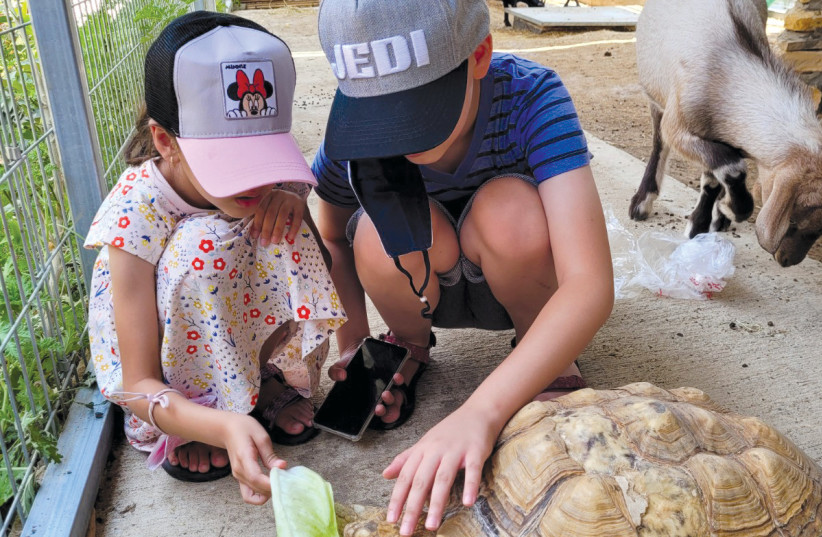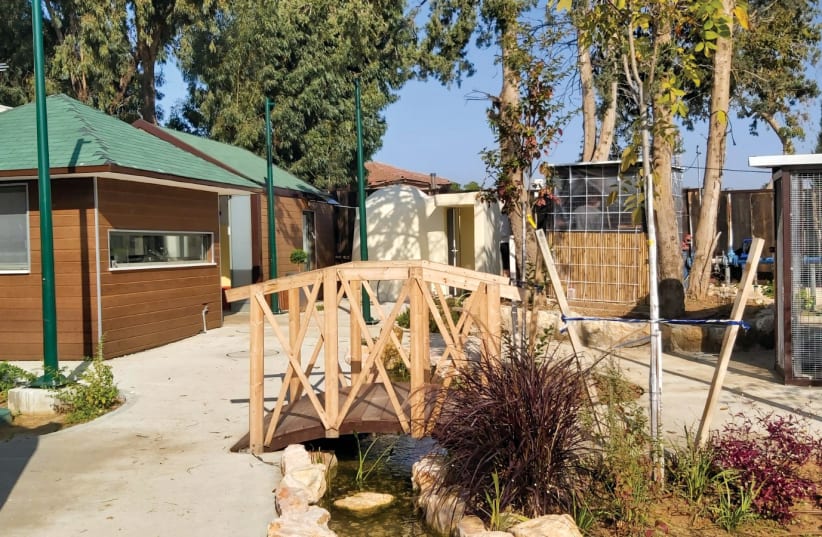
The Australian visitor is very tentatively holding an albino corn snake. Other visitors cautiously touch it. Like most people, these guests at the Sderot Animal-Assisted Therapy Center have an innate fear of snakes. Though Boten (“Peanut”) the snake is used to being passed around, these humans are being asked to note their physical responses to handling it.
“Holding a snake is an opportunity to understand our fears and how our body reacts,” says animal-assisted-therapist Gillie Pragai Olswang, the guide for this tour of the center. “I can feel what happens to my body when I hold the snake: My heart beats faster, I stop breathing, and then, gradually, I relax. Afterwards, we can talk about our physical reaction.”
The group from Sydney, Australia, was recently touring the newly opened wing of the center in this western Negev town, funded by the Jewish National Fund of Australia (JNFA).
Sderot: A city under fire and trauma
Sderot is the largest town in the area known as “The Gaza envelope” – communities that are less than seven kilometers from the volatile Gaza Strip border and thus within range of mortar shells and Qassam rockets launched from Gaza. In the ongoing conflict, there have been large-scale escalations since 2001 and many rounds of fighting in between.
Although the situation has been mostly quiet for nearly two years, in January a new round of rocket alarms sounded in Sderot and nearby towns as Israeli Air Force warplanes carried out sorties in Gaza in response to a rocket attack. Two decades of regular missile attacks have left many residents in a chronic state of trauma. Even when an immediate danger may have passed, long-term traumatic effects remain in the form of anxiety, depression, insomnia, fear of noises, exaggerated vigilance and, especially in children, nightmares and bed-wetting. The COVID-19 pandemic amplified levels of anxiety, as well as violent behavior.


The Sderot Animal-Assisted Therapy Center was established seven years ago with funding from JNF-USA and JNF-Canada to provide treatment to children and teenagers from the city and surrounding towns suffering from post traumatic stress disorder, or PTSD. The center is staffed by professional therapists specializing in the area of trauma.
Animal-assisted therapy has proven an important tool in helping people cope with various conditions, including trauma. Interacting with animals tends to create a bond that can be calming. It also encourages people to talk about their emotions without feeling exposed or vulnerable. “A child will say ‘I wasn’t frightened by the red alert [warning siren] yesterday, but the rabbit really was scared,’” relates former center director Hagar Shnell. “You talk about the animal, but you’re really talking about yourself; it’s a kind of projection.”
“You talk about the animal, but you’re really talking about yourself; it’s a kind of projection.”
Hagar Shnell
A person in survival mode doesn’t normally think of anything else but himself; but, adds Shnell, when there are emergencies, children who have come to the center are concerned about the animals.
“When they have something to look after, their symptoms are somehow reduced,” she says. “They have a ‘job’, and being responsible for someone else means they tend to be less stressed and hysterical.”
As you enter the compound, you’re immediately struck by the peaceful atmosphere, even with the constant melody of the exotic songbirds in the aviaries. Close to the entrance is a large ecological lily pond. There’s something very soothing about watching goldfish swim among the aquatic plants in the pool. “Sometimes the children sit at the edge of the pool just to calm down,” says Olswang. “They absorb the silence; it gives children who are fearful of going to different places a feeling of security, and sometimes a way to express their feelings.”
A variety of animals are grouped in separate enclosures which the children can enter. There are rabbits, chinchillas, hamsters, several varieties of chickens, exotic birds, goats, and an assortment of reptiles.
Sderot’s Animal-Assisted Therapy Center is part of the Roklen Resilience Center in Sderot, one of the country’s dozen Hosen centers which offer free psychological-emotional support and therapy in communities where there are security threats or social conflicts.
In addition to Sderot, there are Hosen centers in several communities in the Negev, such as Eshkol, Hof Ashkelon, Shaar HaNegev, Sdot Negev and Bedouin communities. Hosen centers (the word means “resilience” in Hebrew) were established more than 20 years ago to help residents cope with continuing fear and trauma. They’re funded by Israeli government agencies, the Jewish National Fund- USA and Keren Kayemeth Le’Israel.
During the Australian group’s tour, Zelda, a 16-year-old tortoise, lumbers onto the path. It turns out that there’s more than one way to look at the heavily armored tortoise, relates Olswang a lecturer in animal-assisted interventions at the David Yellin Academic College of Education in Jerusalem. “One parent who brought his daughters to the center was so anxious himself that he wouldn’t let his children go outside except to school, afraid something bad would happen to them,” she says. “The father thought Zelda the tortoise was ‘vulnerable because there’s nothing to protect his neck.’ But his girls pointed out his strength and said they wanted to have a strong and safe place like the tortoise.”
The new wing of the Sderot center, opened officially in October, was constructed in response to the increasing demand for the center’s services. Sderot’s population of more than 30,000 is steadily growing, despite the continued threat of rocket and mortar attacks from Gaza.
“The situation in Sderot is not post-trauma, it’s ongoing. It never stops,”
Alon Davidi
“The situation in Sderot is not post-trauma, it’s ongoing. It never stops,” Sderot Mayor Alon Davidi recently told Ynet.
The new wing is beautifully landscaped, with paths lined with flowering bushes and herbs. It’s nearly four times as large as the original compound and will accommodate double the number of participants, as well as open it to residents of more communities in the region. The rooms and enclosures are fortified, which means that if there’s a warning siren, people don’t have to run for cover.
A variety of animals are housed inside the spacious bomb shelter, including a giant fish tank, chinchillas, hamsters and different species of lizards. It’s also the home of small, delicate insects called Phasmatodea, or “stick insects,” whose legs look like walking sticks. To hold these tiny harmless creatures in your hand, as some children choose to do, one must be extremely gentle. “If you put something so delicate in the palm of a kid with violent tendencies, he becomes the gentlest kid in the world,” Olswang explains. “We teach different techniques, but the animals do 75% of the work in what they bring out in the child,” she adds.
Israel has become a world leader in animal therapy. There are several centers around the country which treat people with various types of addiction and mental illness, as well as many therapeutic petting zoos, some of which are attached to schools. The Sderot center is the largest and most elaborate in Israel, and other cities in the country are asking for help in building their own centers. Many groups visit Sderot from abroad to learn how to help refugees deal with trauma by using animals, most recently from Ukraine.
Gaza, less than a mile away, is easily seen from the Sderot hills. Shnell, one of the planners of the new wing, admits that she thinks about the children in Gaza and wishes that they too had a similar animal therapy center. “I think about this a lot, as do the children here who talk about it. You can’t imagine how traumatic it is.”
“One of the things that working with animals allows is connection and emotional attachment,” states Ronna Kramer-Gabay, a retired special education teacher who incorporated animal-assisted therapy in her work for many years with children in Beersheba. “The presence of animals can reduce the level of tension and help the children work things out – with the animals and with their own lives. They can worry about the animals instead of worrying about themselves, which is easier for them to handle.” ■
